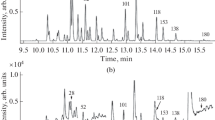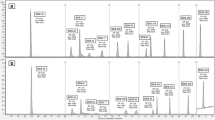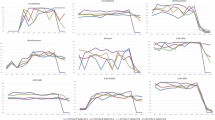Abstract
The 209 polychlorinated biphenyl (PCB) congeners exhibit a wide range in toxicity to fish, birds, and mammals. This paper discusses the use of gas chromatography/mass spectrometry negative chemical ionization (GC/MS-NCI) to quantify congeners of highly suspected toxicity such as IUPAC #77 (3,3′,4,4′-tetrachlorobiphenyl) and #126 (3,3′,4,4′,5-pentachlorobiphenyl). GC/MS analysis time needed to produce the necessary resolution was reduced to 1 h per sample or standard, allowing an autosampler to inject 12 samples in 24 hours, plus 12 standards/QC samples. Identification and quantification of some 60+ congeners and several selected pesticides and estimation of total PCBs are also possible within the 1 h analysis. For congeners of high chlorination (penta through octa), the method exhibited excellent sensitivity, such that we could not locate a fish which exhibited PCB levels below our calibrated quantitation range. NCI was not as sensitive for mono through tri and for some tetrachlorinated PCB congeners, an exception being PCB #77, for which sensitivity was of the same order as for the more highly chlorinated biphenyls. Long term stability was excellent. Over a 6-mo period, results of replicate analyses for PCB congeners and pesticides in a composited sample of lake trout (Salvelinus namaycush) from Lake Michigan had a relative standard deviation of 12% of the mean. Over the same time period, mean recoveries for samples spiked at concentrations similar to those in Lake Michigan lake trout were 90–102%. Response was linear over a wide range of concentrations for each of the analyzed compounds. This method is now being used for routine analysis of PCB congeners and selected pesticides in our laboratory.
Similar content being viewed by others
References
Alfred-Stevens AL, Bellar TA, Eichelberger JW, Budde WL (1986) Characterization of commercial Aroclors by automated mass spectrometric determination of polychlorinated biphenyls by level of chlorination. Anal Chem 58:2014–2022.
Crow FW, Bjorseth A, Knapp KT, Bennet R (1981) Determination of polyhalogenated hydrocarbons by glass capillary gas chromatography-negative ion chemical ionization mass spectrometry. Anal Chem 53:619–625.
Dewailly E, Weber JP, Gringras S, Laliberte C (1991) Coplaner PCBs in human milk in the province of Quebec, Canada: Are they more toxic than dioxin for breast fed infants? Bull Environ Contam Toxicol 47:491–498
Dougherty RC, Whitaker MJ, Smith LM, Stalling DL, Kuehl DW (1980) Negative chemical ionization studies of human and food chain contamination with xenobiotic chemicals. Environ Health Perspect 36:103–118
Dougherty RC (1981a) Negative chemical ionization mass spectrometry. Anal Chem 53:625A-636A
— (1981b) Negative chemical ionization mass spectrometry: applications in environmental analytical chemistry. Biomed Mass Spectrom 8:283–291
Duinker JC, Schulz DE, Petrick G (1988a) Multidimensional gas chromatography with electron capture detection for the determination of toxic congeners in polychlorinated biphenyl mixtures. Anal Chem 60:478–482
— (1988b) Selection of chlorinated biphenyl congeners for analysis in environmental samples. Mar Pollut Bull 19:19–25
Erhardt-Zabik S, Watson JT, Zabik MJ (1990) Selective sensitivity of highly chlorinated species in negative ion mass spectrometry: implications for complex mixture analysis. Biomed Environ Mass Spectrom 19:101–108
Erickson MD, Stanley JS, Thurman JK, Going JE, Redford DP, Heggem DT (1988) Determination of by-product polychlorobiphenyls in commercial products and wastes by high-resolution gas chromatography/electron impact mass spectrometry. Environ Sci Technol 22:71–76
Greaves J, Roboz J, Holland JF, Bekesi JG (1984) Determination of the binding of polybrominated biphenyls to serum proteins by negative chemical ionization mass spectrometry. Chemosphere 13:651–656
Hass JR, Friesen MD, Harvan DJ, Parker CE (1978) Determination of polychlorinated dibenzo-p-dioxins in biological samples by negative chemical ionization mass spectrometry. Anal Chem 50:1474–1479
Hesselberg RJ, Johnson JL (1972) Column extraction of pesticides from fish, fish food, and mud. Bull Environ Contam Toxicol 7:115–120
Huckins JN, Schwartz TR, Petty JD, Smith LM (1988) Determination, fate, and potential significance of PCBs in fish and sediment samples with emphasis on selected AHH-inducing congeners. Chemosphere 17:1995–2016
Huckins JN, Stalling DL, Petty JD (1980) Carbon-foam chromatographic separation of non-o,o′-chlorine substituted PCBs from Aroclor mixtures. J Assoc Offic Anal Chem 63:750–755
Kannan N, Tanabe S, Tatsukawa R (1988) Potentially hazardous residues of non-orthochlorine substituted coplaner PCBs in human adipose tissue. Arch Environ Health 43:11–14
Kassel DB, Kayganich KA, Watson JT, Allison J (1988) Utility of ion source pretreatment with chlorine-containing compounds for enhanced performance in gas chromatography/negative ionization mass spectrometry. Anal Chem 60:911–917
Kuehl DW, Butterworth BC, Libal J, Marquis P (1991) An isotope dilution high resolution gas chromatographic-high resolution mass spectrometric method for the determination of coplaner polychlorinated biphenyls: application to fish and marine mammals. Chemosphere 22:849–858
Lewis E, Jamieson E (1983) Use of negative chemical ionization GC/MS to study polychlorinated biphenyls in marine sediments. Int Mass Spectrom Ion Phys 48:303–306
Maack L, Sonzogni W (1988) Analysis of polychlorobiphenyl congeners in Wisconsin fish. Arch Environ Contam Toxicol 17:711–719
McFarland VA, Clarke JU (1989) Environmental occurrence, abundance, and potential toxicity of polychlorinated biphenyl congeners: considerations for a congener-specific analysis. Environ Health Perspect 81:225–239
Niimi A, Oliver B (1989) Distribution of polychlorinated biphenyl congeners and other halocarbons in whole fish and muscle among Lake Ontario salmonids. Environ Sci Technol 2:83–88
Oehme M (1982) Mass spectrometry and the analysis of ultratrace quantities of chlorinated compounds in arctic air. Trends Anal Chem 1:321–323
— (1983) Determination of isomeric polycyclic aromatic hydrocarbons in air particulate matter by high-resolution gas chromatography/negative ion chemical ionization mass spectrometry. Anal Chem 55:2290–2295
Oehme M, Stöckl D, Knöppel H (1986) Comparison of the reproducibility of negative ion chemical ionization mass spectra obtained by different reagent gases on two commercial quadrupole instruments. Anal Chem 58:554–558
Ribick MA, Dubay GR, Petty JD, Stalling DL, Schmitt CJ (1982) Toxaphene residues in fish: identification, quantification, and confirmation at part per billion levels. Environ Sci Technol 16:310–318
Roboz J, Greaves J, Holland JF, Bekesi JG (1982) Determination of polybrominated biphenyls in serum by negative chemical ionization mass spectrometry. Anal Chem 54:1104–1108
Sawyer TW, Vatcher AD, Safe S (1984) Comparative aryl hydrocarbon hydroxylase induction activities of commercial PCBs in Wistar rats and rat hepatoma H-4-II E cells in culture. Chemosphere 13:695–701
Sawyer TW, Safe S (1985) In vitro AHH induction by polychlorinated biphenyl and dibenzofuran mixtures: additive effects. Chemosphere 14:79–84
Sears LJ, Campbell JA, Grimsrud EP (1987) Ionization dynamics within the high pressure electron capture mass spectrometer; the unusual spectra of derivatized polycyclic aromatic amines and perchlorinated unsaturated hydrocarbons. Biomed Environ Mass Spectrom 14:401–415
Smith LM, Schwartz TR, Feltz K, Kubiak TJ (1990) Determination and occurrence of AHH-active polychlorinated biphenyls, 2,3,7,8-tetrachloro-p-dioxin and 2,3,7,8-tetrachlorodibenzofuran in Lake Michigan sediment and biota. The question of their relative toxicological significance. Chemosphere 21:1063–1085
Stalling DL, Schwartz TR, Dunn WJ III, Wold S (1987) Classification of polychlorinated biphenyl residues: isomers vs. homologue concentrations in modeling aroclors and polychlorinated biphenyl residues. Anal Chem 59:1853–1859
Stemmler EA, Hites RA, Arbogast B, Budde WL, Deinzer ML, Dougherty RC, Eichelberger JW, Foltz RL, Grimm C, Grimsrud EP, Sakashita C, Sears LJ (1988) Interlaboratory comparison of methane electron capture negative ion mass spectra. Anal Chem 60:781–787
Stemmler EA, Hites RA (1985) Methane enhanced negative ion mass spectra of hexachlorocyclopentadiene derivatives. Anal Chem 57:684–692
— (1988) Electron capture negative ion mass spectra of halogenated diphenylethane derivatives. Anal Chem 60:787–792
Swackhamer DL, Charles MJ, Hites RA (1987) Quantitation of toxaphene in environmental samples using negative ion chemical ion mass spectrometry. Anal Chem 59:913–917
Tanabe S (1988) PCB problems in the future: foresight from current knowledge. Environ Pollut 50:5–28
Tanabe S, Kannan N, Subramanian A, Watanabe S, Tatsukawa R (1987a) Highly toxic coplaner PCBs: occurrence, source, persistency and toxic implications to wildlife and humans. Environ Pollut 47:147–163
Tanabe S, Kannan N, Wakimoto T, Tatsukawa R (1987b) Method for the determination of three toxic non-orthochlorine substituted coplaner PCBs in environmental samples at part-per trillion levels. Int Environ Anal Chem 29:199–213
Tindle RC, Stalling DL (1972) Apparatus for automated gel permeation cleanup for pesticides residue analysis. Anal Chem 44:1768–1773
Van der Oost R, Heida H, Opperhuizen A (1988) Polychlorinated biphenyl congeners in sediments, plankton, molluscs, crustaceans, and eel in a freshwater lake: Implications of using reference chemicals and indicator organisms in bioaccumulation studies. Arch Environ Contam Toxicol 17:721–729
Voyksner RD, Bursey JT, Pack TW, Porch RL (1986) Development of methane positive chemical ionization gas chromatography/mass spectrometry procedures to determine polychlorinated biphenyls. Anal Chem 58:621–626
Author information
Authors and Affiliations
Additional information
Contribution 799 of the National Fisheries Research Center-Great Lakes, U.S. Fish and Wildlife Service, 1451 Green Road, Ann Arbor, MI 48105.
Rights and permissions
About this article
Cite this article
Schmidt, L.J., Hesselberg, R.J. A mass spectroscopic method for analysis of AHH-inducing and other polychlorinated biphenyl congeners and selected pesticides in fish. Arch. Environ. Contam. Toxicol. 23, 37–44 (1992). https://doi.org/10.1007/BF00225993
Received:
Revised:
Issue Date:
DOI: https://doi.org/10.1007/BF00225993




